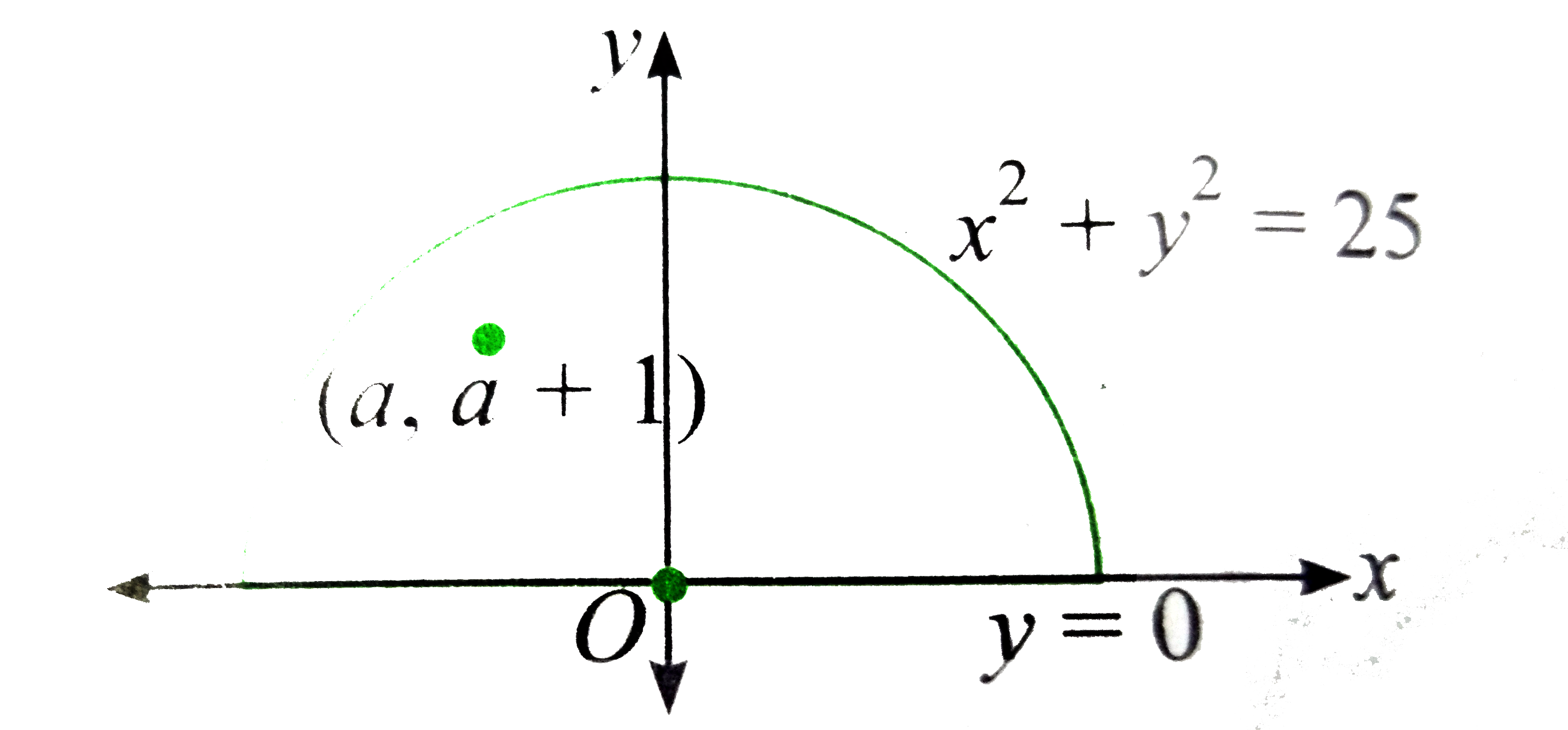A region in the x−y plane is bounded by the curve y=√25−x2 and the line y=0 . If the point (a,a+1) lies in the interior of the region, then (a)a∈(−4,3) (b) a∈(−∞,−1) ∪ (3,∞) (c)a∈(−1,3) (d) none of theseSolution in Bengali
a∈(−4,3)
a∈(−∞,−1)∈(3,∞)
a∈(−1),3)
none of these
The correct Answer is:3

y=√25−x2 and y=0 bound the semicircle above the x-axis .
Therefore,
a+1>0 (1)
and a2+(a+1)2−25<0 or 2a2+2a−24<0
or a2+a−12<0
or −4<a<3 (2)
From (1) and (2),
−1<a<3
Topper's Solved these Questions
- BOOK - CENGAGE PUBLICATIONCHAPTER - CIRCLE EXERCISE - Multiple Correct Anser Type29videos
CIRCLE
- BOOK - CENGAGE PUBLICATIONCHAPTER - CIRCLE EXERCISE - Linked Comprehension Type (For Problem 1-3)3videos
CIRCLE
- BOOK - CENGAGE PUBLICATIONCHAPTER - CIRCLE EXERCISE - CONCEPT APPLICATION EXERCISE 4.172videos
CIRCLE
- BOOK - CENGAGE PUBLICATIONCHAPTER - BINOMIAL THEOREMEXERCISE - Comprehension11videos
BINOMIAL THEOREM
- BOOK - CENGAGE PUBLICATIONCHAPTER - CIRCLESEXERCISE - Comprehension Type8videos
CIRCLES
Similar Questions
about to only mathematics
04:36View SolutionEach side of a square is of length 6 units and the centre of the square Is ( - 1, 2). One of its diagonals is parallel to x+y=0. Find the co-ordinates of the vertices of the square.
03:59View SolutionThree concentric circles of which the biggest is x2+y2=1, have their radii in A.P If the line y=x+1 cuts all the circles in real and distinct points. The interval in which the common difference of the A.P will lie is:
04:03View SolutionConsider a G.P. with first term (1+x)n, |x|<1, common ratio 1+x2 and number of terms (n+1). Let 'S' be sum of all the terms of the G.P., then
The coefficient of xn is 'S' is04:34View Solution
In the diagram as shown, a circle is drawn with centre C(1,1) and radius 1 and a line L. The line L is tangent to the circle at Q. Further L meets the y-axis at R and the x-axis at P in such a way that the angle OPQ equals θ where 0<θ<π2.
Coordinate of Q is03:12View SolutionIf the point (λ,λ+1) lies inside the region bounded by the curve x=√25−y2 and y-axis , then λ belongs to the interval
(a) (−1,3) (b) (−4,3) (c) (−∞,−4)∪(3,∞) (d) none of these04:04View SolutionA region in the x−y plane is bounded by the curve y=√25−x2 and the line y=0 . If the point (a,a+1) lies in the interior of the region, then a∈(−4,3) (b) a∈(−∞,−1)∈(3,∞) a∈(−1,3) (d) none of these
02:54View SolutionIf the point (k+1,k) lies inside the region bounded by the curve x=sqrt(25-y^(2)) and y- axis.Then .k belongs to the interval
04:22View SolutionIf the point (1,a) lies in between the lines x+y=1 and 2(x+y)=3 then a lies in (i)(-oo,0)uu(1,oo)(ii)(0,(1)/(2))(iii)(-oo,0)uu((1)/(2),oo)(iv) none of these
06:58View SolutionThe area (in sq units) of the region bounded by the curve y=sqrt(x) and the lines y=0,y=x-2, is
03:01View SolutionFind the area of the region bounded by the curves y=√x+2andy=1x+1 between the lines x=0 and x=2.
02:46View SolutionThe area of the region bounded by the curve C:y=x+1x2+1 nad the line y=1 , is
03:54View SolutionIf the point (k+1,k) lies inside the region bound by the curve x=√25−y2 and the y-axis, then the integral value of k is/are
03:55View SolutionThe area of the region bounded by curves y=1−x2,x+y+1=0andx−y−1=0 is
02:59View SolutionA region in the x−y plane is bounded by the curve y=√25−x2 and the line y=0 . If the point (a,a+1) lies in the interior of the region, then (a)a∈(−4,3) (b) a∈(−∞,−1) ∪ (3,∞) (c)a∈(−1,3) (d) none of these
03:13View SolutionFind the area of the region bounded by the curves y=√x+2andy=1x+1 between the lines x=0 and x=2.
03:25View Solution

